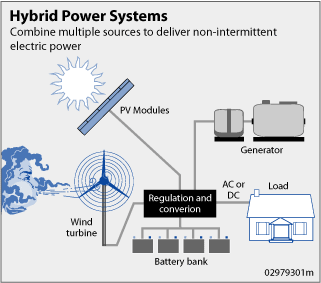Contemplative point 2: Running a city takes energy. The former feeds off the latter to survive.
Energy: it can neither be created nor destroyed; only changed. Energy can be friend or foe; an asset or detriment, in other words. Energy is responsible for bringing to life things that we often take for granted like lit lights, mechanized/motorized travel and cooked food. Energy as a power source can be derived both from within (as in humans having the power to produce energy manually) and without (as through harnessing energy from the sun, wind or tide – examples of renewable means of energy production). And, in terms of large-scale practical application, that cities function as they do, energy enables this.
What are some of the things we expect cities to have: Academic institutions; municipal services such as fire and police protection, medical service entities – the healthcare aspect; water and waste treatment; electricity and natural gas distribution and other types of distribution and infrastructure; a governing system and body; housing; jobs; cultural and entertainment options; recreational opportunities; and religious institutions and facilities. These and other things are the fundamental ingredients that make cities tick. Most importantly about cities, in my view, is they are nothing without people. Furthermore, imagine getting day-to-day chores done without such conveniences as electricity, instead relying exclusively on manual physical labor to get the tasks at hand done right. Pretty tough to imagine. Which is why, in the context of cities and everyday life, having available to us and at the ready an external energy supply goes without saying.
With the above in mind, I present “Terms and conditions: Our impact on Earth; its impact on us – Part 3.”
Where our energy is coming from
Biomass – watts from waste.
In the Golden State, California, because of bark beetle infestations and the recent drought, 100 million trees in the Sierra Nevada Mountains have died. Over the disposition of these trees there has been and is debate. Some have suggested truck-hauling such to biomass plants for further processing where the material can be burned and later turned into electricity. For others, meanwhile, who, because of their accepting as real the notion of anthropogenic climate change or global warming or both, they, quite honestly, might feel that by forwarding by polluting truck said trees to such biomass sites to be incinerated for the purpose of generating electricity – a polluting process also, by the way – such measures run counter to what they believe is right. For this group, it could very well be that they see just such a move as but yet another contributing factor in the climate change/global warming equation. A “Catch-22” if you get my drift.
On the other hand, for some, in their understanding that all of the carbon dioxide absorbed and stored by these trees when alive will eventually get released back into the atmosphere anyway, their arguing that the trees, as biomass stock is the more environmentally-friendly way of such being disposed of, makes far more sense compared to leaving the trees in the wilderness to decompose naturally.
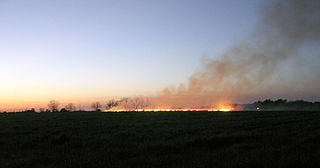
As somewhat of an aside, it used to be that in the San Joaquin Valley most agricultural waste was set ablaze in the open field. That was before rules were put in place to curb this activity. As it happens, the prohibition of open field ag-waste burning in the Valley actually led to somewhat improved area air quality.
Meanwhile, Natural Resources Defense Council Senior Scientist Peter Miller in his “A Golden Future for the Renewable State,” April 19, 2011 Expert Blog post wrote: “While Congress stalls on America’s clean energy future, California is already making renewable energy the resource with which we’ll power our way to the future. Just last month, the California Legislature passed the 33 percent Renewable Portfolio Standard with broad bipartisan majorities. This legislation increases the share of renewable energy supplied by electricity providers to 33 percent by 2020.” As spelled out in the legislation in question, biomass, among a host of other renewables, was named.
That all said and despite being considered a renewable-energy-supply offering, biomass receives and has received its share of criticism.
Coal – under growing pressure (or so it would “seam”).

Being that coal is the world’s most plentiful fossil fuel, it should not come as a surprise that our history with the black carbonaceous rock would go back centuries. But, being dependent on coal for the length of time humans have doesn’t mean things have to always be this way. Breaking the coal-dependence, coal-burning habit has been slow going. But, this is exactly what is occurring.
Looking north, here is what Canada is slated to do. In a May 8, 2013 “Canada continues to align air emissions measures with the United States” Transport Canada press release, in the “other actions” categories that were mentioned in the release, among them was “to reduce GHGs from coal-fired electricity plants, which will reduce GHGs by 214 megatonnes over the period 2015-2035. Canada is the only nation with regulations banning the construction of new coal-fired power plants that use traditional technology. As well, we now require all existing plants to shut down on a schedule, making Canada the first country in the world to do so.” A promising, if not humble, beginning indeed!
Coal-burning obviously results in much pollution pouring into the air through smokestack releases. In America, according to the U.S. Energy Information Administration (EIA), coal-burning in 2016 was responsible for generating 30 percent of this country’s electricity needs. This is down from about 50 percent in 2012. This compares with 40 percent coal electricity production worldwide.
Geothermal – letting off a lot of steam.
Geothermal is what its name implies – heat from the earth. The trick is to capture the steam heat and put it to good use. The steam in turn can be used to create electricity. (Refer to the coal-fired power plant illustration above).
Hydropower – watts from water.
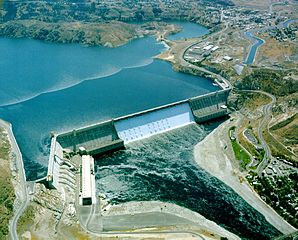
It’s an awesome, powerful sight. Water just gushing out of chutes at the base of a hydroelectric facility, water only seconds before being the kinetic energy that turned the turbine blades of associated generators whose mechanical action has been converted to electrical energy, after which the water itself emptying into a river upon its release into such. From what I remember, the efficiency rating of hydropower is at best about 35 percent. Hydroelectric power is the least polluting of all energy production types. In 2011, hydro displaced three billion tons of carbon dioxide gases that would have been released into the atmosphere had the energy been produced using fossil fuels all things being equal.
Natural gas – most environmentally friendly of the fossil-fuels class.
Within the fossil-fuels genus, natural gas is, arguably, the most environmentally-friendly, non-renewable fuel out there.
In terms of its abundance, natural gas is right up there with coal. And, it is one infrastructure type – pipelines – through which this natural resource is able to get to and provide energy for the people and places it does.
Also, like coal, oil and petroleum, natural gas reserves are located subsurface. According to the Natural Resources Defense Council, as it happens about 1 in 20 Americans (over 15 million) reside within a mile of a hydraulic fracturing site, all of which means natural gas is in high demand.
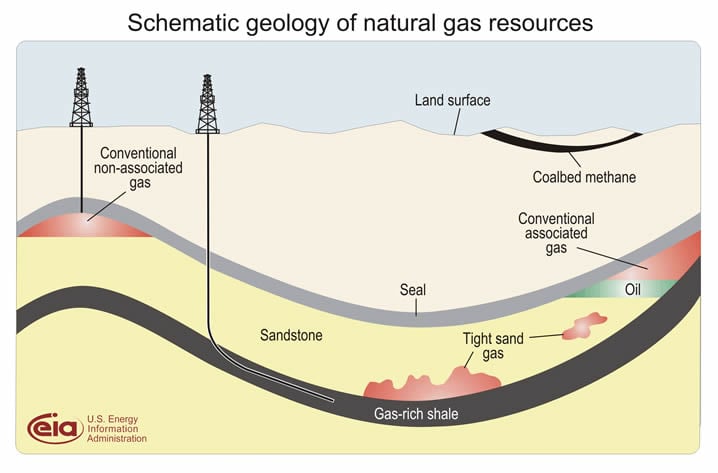
In elaborating, a report by the Natural Resources Defense Council (NRDC) entitled: Fracking’s Most Wanted: Lifting the Veil on Oil and Gas Company Spills and Violations the NRDC emphasized, “is an investigation into whether information about oil and gas company violations is publicly available nationwide, as well as the accessibility and reliability of the information that does exist.”
Adding to the pain if you will is that the NRDC discovered that less than a handful of states (three) – Colorado, Pennsylvania and West Virginia – have company violation data that is available and accessible to the public.
The environmental watchdog group adding the types of incidents/infractions were wide-ranging including “… spills, drinking water contamination, illegal air pollution, improper construction or maintenance of waste pits, failure to conduct safety tests, improper well casing, and nonworking blowout preventers.”
Natural gas, meanwhile, according to the EIA, provides 34 percent of America’s electricity-generating capacity.
Nuclear – handle with care.
Practically everyone is aware of the danger of a reactor meltdown. Even so, some people swear by it; others, meanwhile, no doubt swear at it; most, probably, are indifferent to it, it, of course, being nuclear energy.
Then there is the matter of nuclear waste disposal. Hence, the “handle with care” reference above. But, on the bright side, nuclear as an energy supply is clean, which is probably why it has gained acceptance by many.
It really doesn’t make much sense in going into deeper detail here. But, know this: According to the U.S. EIA, nuclear energy accounts for roughly 20 percent of all electricity produced in the United States.
Oil – an “exhaust”ible supply
Oil, petroleum, sun and wind round out the supply-of-energy or energy source category. Growing up and living on the east coast, I am quite familiar with home heating systems that utilize oil – delivered in trucks – as a feedstock for allowing for furnace-produced heating. I remember my grandparents had a large tank in their basement for storing such oil. I never gave any thought about the impact to the air such oil burning had. If I remember correctly, the City of New York has gotten behind a movement to get away from producing heat for buildings this way.
Petroleum – liquid gold refined.
Ditto for petroleum. Petroleum is the main source of energy for providing America’s near 260 million motor vehicles the power to move.
Contemplative point 3: As more and more zero-emissions motor vehicles hit the streets now and in the years to come, there will be less and less gasoline (also known as petrol) and diesel dependence.
Sun – a “shining” example.
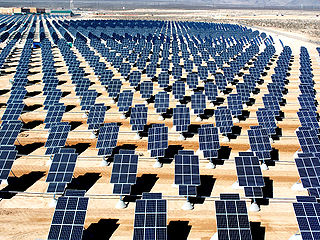
Wind – head, tail or otherwise … and all of it works just fine.
As of December 2012, in the U.S. there were some 36,000 wind-turbine generators. That’s an average of 720 wind turbines per state.
The main drawback, of course, is a lack of wind. Others include birds flying into spinning wind-turbine blades and there is the aesthetics. Some people just think they’re flat-out unsightly.
Wind turbines come in various configurations.
Etc.
Other methods of generating electricity are being studied and/or developed and/or tested.
An excellent resource to reference to learn more about what cities throughout the world are doing to make their air cleaner involving practices, programs and projects with a direct tie to energy is the “Cities 100” document.
To read “Terms and conditions: Our impact on Earth; its impact on us” parts 1 and 2 check here and here, respectively.
To be continued.
Images: Tennessee Valley Authority (2nd from top); U.S. Energy Information Administration (4th from top); United States Air Force (2nd from bottom); and U.S. Department of Energy (bottom)
This post was last revised on May 13, 2020 @ 7:47 a.m. Pacific Daylight Time.
– Alan Kandel
